Driving is a cornerstone of golf, setting the stage for the entire hole. A powerful, accurate drive places you in prime position, while a weak or errant one can spell trouble. Mastering the drive means more than just hitting the ball hard; it’s about control, consistency and confidence. Improving your drive can dramatically enhance your game, reducing frustration and boosting self-esteem.
This guide will equip you with practical advice on selecting the right equipment, perfecting your stance and grip, improving your swing mechanics, and overcoming common challenges.
Let’s get started!
- 1) Preparing for the Drive
- 2) Perfecting Your Stance and Grip
- 3) The Swing Mechanics
- 4) Overcoming Common Challenges
- 5) Advanced Techniques
- 6) Equipment and Technology
- 7) Practicing Effectively
-
8)
Frequently Asked Questions
- 8.1) What is the best driver for beginners?
- 8.2) How can I hit the golf ball further?
- 8.3) What are the most common mistakes when driving the ball?
- 8.4) How important is the follow-through in a golf swing?
- 8.5) Should I adjust my stance for different types of shots?
- 8.6) What are the best warm-up exercises before driving?
- 9) Final Thoughts
Preparing for the Drive
Selecting the right driver can make a significant difference in your game. Start by considering the loft of the club. Higher lofts (10.5 degrees and above) are generally easier to hit and provide more control, making them ideal for beginners. Lower lofts (below 10.5 degrees) cater to more experienced players looking for greater distance.
Shaft flex is another critical factor. Your swing speed should dictate the flex you choose. Slower swing speeds benefit from more flexible shafts, while faster swing speeds require stiffer shafts.
The clubhead design also matters, as modern drivers come with adjustable features that allow you to tweak the loft, lie and face angle to suit your swing.
Proper Golf Attire and Gear
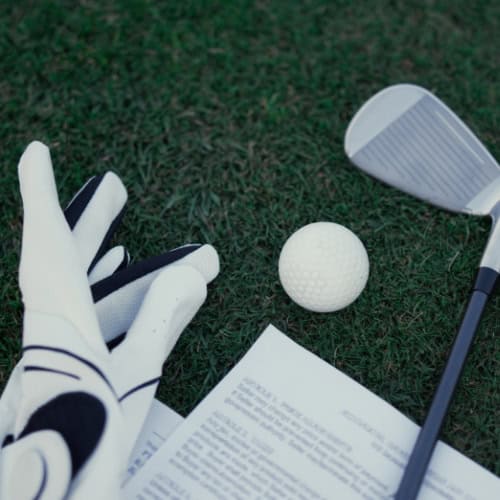
Comfort and mobility are key when it comes to golf attire. Choose lightweight, breathable fabrics that allow a full range of motion. Look for moisture-wicking materials to keep you dry and comfortable throughout your round.
Proper golf shoes provide the stability and traction needed for a powerful swing. Opt for shoes with good support and consider weather conditions when selecting between spiked and spikeless designs.
Gloves are also essential for maintaining a secure grip, especially in humid conditions. A well-fitted glove enhances your connection with the club, preventing slippage during your swing. Sunglasses and a hat can protect you from the sun, while rain gear is a must-have for unpredictable weather.
Setting Up the Tee and Ball
Correctly setting up your tee and ball can set the stage for a successful drive. Position the ball so that its top half is above the clubface when the driver is grounded. This ensures optimal contact for distance and accuracy. Tee height varies based on personal preference and the club being used, but a good rule of thumb is to have half the ball above the top edge of the driver.
Place the tee in line with your front foot. This positioning helps you strike the ball on the upswing, maximizing distance. For a more controlled drive, consider lowering the tee slightly and placing it closer to the center of your stance.
Importance of Warm-Up Exercises
Warming up is crucial for preventing injuries and improving performance. Start with dynamic stretches to increase blood flow and flexibility. Focus on your shoulders, hips and back, as these areas are heavily involved in your swing. Gentle rotations and swings with a club can help loosen your muscles and joints.
Incorporate some light aerobic activity to get your heart rate up. This could be a brisk walk or a few minutes of jumping jacks. Finally, practice a few swings with a lighter club to fine-tune your motion and timing. A proper warm-up routine primes your body for the physical demands of driving the ball, helping you perform at your best.
Perfecting Your Stance and Grip
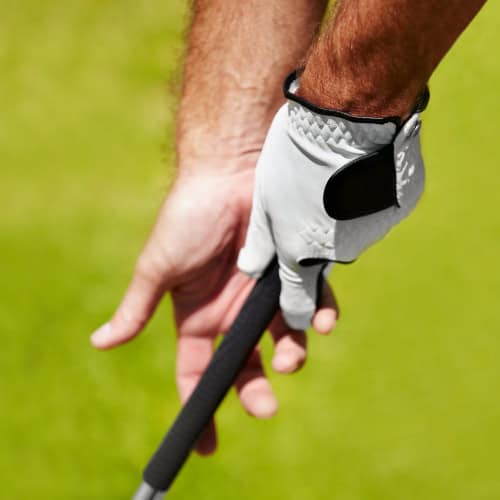
A solid stance is the foundation of a successful drive. Start by positioning your feet shoulder-width apart. This stance provides stability and balance. Your weight should be evenly distributed between both feet. Slightly bend your knees to stay flexible and ready to move. Your spine should tilt forward slightly, keeping your back straight. This posture helps maintain your center of gravity.
The Correct Way to Hold the Driver
Your grip can make or break your drive. Hold the club with a relaxed grip to allow for a natural swing. Place your left hand on the club first (if you are a righty), ensuring the grip lies diagonally across your fingers. Your thumb should point down the shaft. Next, place your right hand below your left, with your pinky overlapping the index finger of your left hand. This interlocking grip provides control and stability.
Common Mistakes to Avoid
Many golfers struggle with stance and grip issues that hinder their drives. Avoid a stance that’s too narrow or too wide; both can throw off your balance. Gripping the club too tightly also restricts your swing, leading to a loss of power.
Another common error is placing the ball too far forward or back in your stance, which can result in poor contact. Practice regularly to develop a consistent setup that feels natural.
Mastering your drive is not just about technique, but also about understanding the competitive spirit of the game. Learning about legendary clashes on the green can provide inspiration and context for your own golfing journey.
The Swing Mechanics

A successful drive in golf depends on the proper execution of three key phases: the backswing, the downswing, and the follow-through.
During the backswing, the focus is on turning the shoulders away from the target while keeping the lower body stable, creating a wide arc with the arms to build tension and store energy for the downswing. It’s crucial to keep the clubface square to the target line and maintain a smooth, controlled motion.
The downswing is all about generating power through timing and coordination. It begins with a weight shift from the back foot to the front foot, initiating the release of stored energy from the backswing. The hips rotate towards the target, followed by the hands and arms, while the wrists remain relaxed to allow a natural release of the clubhead. The key is to accelerate through the ball with a smooth tempo, letting the club do the work.
After impact, a proper follow-through is essential for consistency and power. The body should continue rotating towards the target, with the weight fully transferred to the front foot and the back heel lifted off the ground. The arms extend naturally, and the club finishes high above the shoulder, indicating good balance and tempo throughout the swing. A solid follow-through not only ensures better shots but also reduces the risk of injury.
Tips for Improving Accuracy and Distance

You’re on the tee box, ready to unleash a powerful drive down the fairway. But how can you make sure your ball flies straight and far? Let’s explore some key tips to help you boost your accuracy and distance off the tee.
Adjusting Your Grip Pressure
Your grip is your only connection to the club, so it’s critical to get it right. Many golfers grip the club too tightly, causing tension in the hands and forearms. This tension can lead to a loss of clubhead speed and control.
Try to maintain a grip pressure that allows the club to move freely through your hands during the swing. Imagine holding a small bird – firm enough so it doesn’t fly away, but gentle enough not to hurt it.
Utilizing Wrist Hinge Effectively
Proper wrist hinge can add a significant amount of power to your drives. As you take the club back, allow your wrists to hinge naturally, creating a 90-degree angle between your left arm and the club shaft. This angle stores energy that will be released on the downswing.
Be careful not to overdo the wrist hinge or to force it too early in the backswing. Let it happen naturally as you reach the top of your swing. Proper timing of the wrist hinge can lead to more consistent, powerful drives.
Timing and Tempo in Your Swing

A well-timed, smooth swing tempo is key to generating maximum clubhead speed and maintaining accuracy. Many amateurs rush their downswing, throwing off their timing and causing inconsistent contact.
A good way to practice is by counting “one” on your backswing, “two” at the top of your swing, and “three” on your downswing and follow-through. This simple count can help you develop a more consistent, powerful swing tempo.
Drills for Increasing Distance
If you want to add some extra yards to your drives, try these simple drills:
- The Step Drill: Take your normal stance, then step forward with your lead foot as you start your downswing. This drill encourages weight shift and hip rotation, key components of a powerful swing.
- The Pause Drill: Make your normal backswing, but pause for a second at the top before starting your downswing. This drill can help you maintain balance and control, leading to more consistent contact.
- The Resistance Band Drill: Attach a resistance band to your clubhead and anchor it to a point behind you. Make swings against the resistance to strengthen your golf muscles and increase your swing speed.
Strategies for Improving Accuracy
Hitting the fairway consistently is just as important as hitting it far. Here are some strategies to improve your driving accuracy:
- Align Your Body: Make sure your feet, hips and shoulders are all aligned parallel to your target line. Proper alignment is essential for hitting straight shots. Don’t forget to tee the ball correctly (as mentioned earlier).
- Pick a Specific Target: Instead of just aiming for the fairway, pick a specific target in the distance, like a tree or a bunker. A precise target will help you focus and make a more committed swing.
Overcoming Common Challenges
Even the best golfers face challenges with their drives from time to time. Slices, hooks and battling the elements can all lead to frustration on the course. Still, with the right techniques and a positive mindset, you can conquer these obstacles.
Correcting a Slice
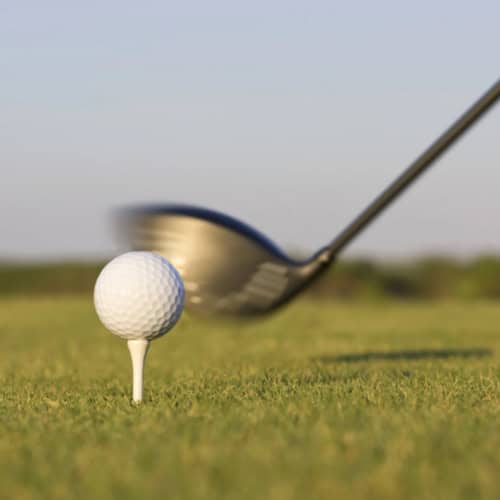
A slice is a shot that curves dramatically from left to right (for right-handed golfers). It’s a common problem that plagues many amateur golfers. The main causes of a slice are an open clubface at impact and an outside-to-inside swing path.
To fix a slice, start by checking your grip. Make sure your hands are rotated slightly to the right on the club, which will help square the clubface at impact. Next, focus on making an inside-to-outside swing path by keeping your right elbow close to your body on the downswing.
Fixing a Hook
A hook is the opposite of a slice – a shot that curves sharply from right to left (for right-handed golfers). Hooks often result from a closed clubface at impact and an inside-to-outside swing path.
To eliminate hooks, try weakening your grip by rotating your hands slightly to the left on the club. This will help prevent the clubface from closing too much at impact. Also, work on making a more outside-to-inside swing path by focusing on keeping your right elbow away from your body on the downswing.
Dealing with Wind and Weather Conditions
Wind and weather can wreak havoc on your drives, but with a few adjustments, you can minimize their impact. When hitting into a headwind, tee the ball slightly lower and make a smooth, controlled swing to keep the ball low and piercing through the wind.
With a tailwind, tee the ball a bit higher and make a more aggressive swing to take advantage of the extra carry distance. In crosswinds, aim slightly into the wind and expect the ball to drift back towards the center of the fairway.
Remember to always factor in the wind when selecting your target and club. A strong headwind may require a longer club, while a tailwind might allow you to hit one less club than normal.
Mental Strategies for a Successful Drive

Golf is as much a mental game as a physical one, and nowhere is this more evident than on the tee box. Doubts, nerves and negative thoughts can all sabotage your drives before you even make a swing.
To combat these mental challenges, start by developing a pre-shot routine. This can include deep breaths, visualizing the shot and focusing on a specific target. Stick to this routine for every drive to create a sense of familiarity and comfort.
Also, embrace the power of positive thinking. Instead of dwelling on past mistakes or worrying about potential hazards, focus on the shot at hand and trust in your abilities.
When you do hit a poor drive, don’t let it derail your round. Accept it, learn from it if possible, and move on. Dwelling on bad shots will only lead to more of them.
Advanced Techniques
Advanced techniques like shaping shots and controlling spin can give you a significant advantage on the course, allowing you to tackle tough hole layouts and tricky wind conditions with confidence.
Learning to Shape Shots
Shaping shots refers to the ability to curve the ball intentionally left or right in flight. This skill is crucial when you need to navigate around obstacles, reach tucked pin positions or compensate for crosswinds.
To hit a fade (a shot that curves gently from left to right for right-handed golfers), aim slightly left of your target and open your stance and clubface slightly at address. Make a normal swing along your body line, and the ball should start left and curve back towards the target.
For a draw (a shot that curves from right to left), do the opposite: aim slightly right of your target, close your stance and clubface slightly and swing along your body line. The ball will start right and curve back left.
Maximizing Spin Control
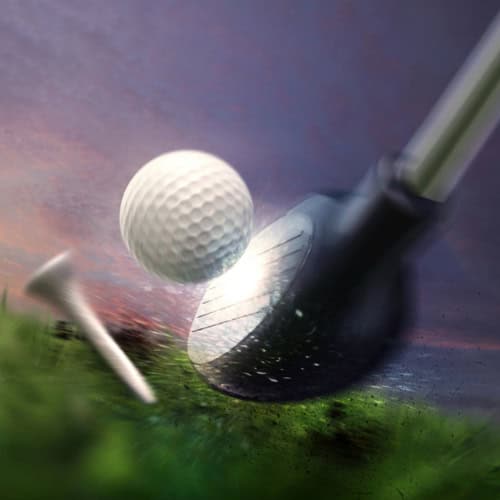
Spin is what makes the ball climb into the air and affects how it behaves when it lands on the green. Too little spin and your drives will lack carry distance; too much spin and you’ll lose control, especially in windy conditions.
To optimize spin, focus on making solid contact with the ball on the clubface’s center. Tee the ball up so that the club strikes it just above the equator at impact. This will help launch the ball high with the right amount of backspin.
Your equipment also plays a role in spin control. Modern drivers are designed with adjustable features that let you fine-tune the launch angle and spin rate to your swing. Work with a club fitter to find the optimal setup for your game.
Implementing Advanced Drills
To ingrain these advanced techniques, incorporate targeted drills into your practice routine. Here are two drills to try:
- The Toe-Heel Drill: Place a tee on the ground and set a ball on it. Take your driver and make alternate swings, hitting the tee with the toe of the club on one swing and the heel on the next. This drill helps you find the club’s sweet spot and develop a feel for centered contact.
- The Trajectory Drill: On the driving range, pick out targets at varying distances and try to hit the ball at different trajectories to land softly by the targets. This drill helps you develop a feel for controlling trajectory and spin.
Remember, these advanced techniques require patience and practice. Don’t get discouraged if you don’t see immediate results. Stick with it, and soon you’ll be shaping shots and controlling spin like a pro.
Equipment and Technology
From the latest driver technologies to the role of golf ball design, understanding how your gear works can help you optimize your game.
Latest Driver Technologies
Golf club manufacturers are constantly pushing the boundaries of innovation to help golfers hit the ball farther and straighter. Some of the latest driver technologies include:
- Adjustable Weighting: Many modern drivers feature adjustable weights that allow you to fine-tune the club’s center of gravity. By moving weight to different positions, you can promote a draw or fade bias or improve forgiveness.
- Aerodynamic Head Designs: Driver heads are now designed with aerodynamics in mind. Features like turbulators and speed steps help reduce drag and increase clubhead speed for more distance.
- Multi-Material Construction: By using a combination of lightweight materials like titanium and carbon fiber, manufacturers can create larger, more forgiving clubheads that still maintain a low center of gravity for optimal launch conditions.
The Role of Golf Ball Design
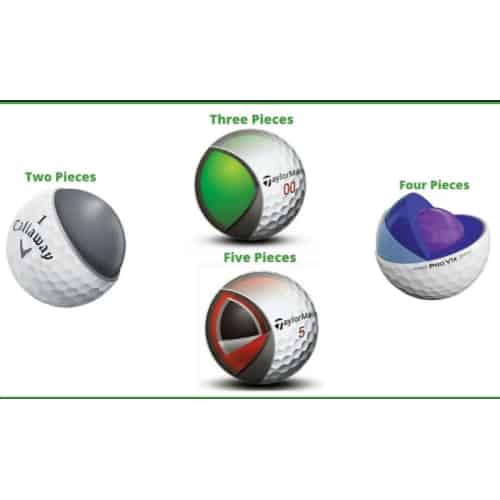
The golf ball you choose can also have a big impact on your driving performance. Different ball designs offer varying levels of distance, spin and control.
- Two-Piece Balls: These balls have a large, solid core and a durable cover. They’re designed for maximum distance and are a good choice for beginners and high-handicappers.
- Multi-Layer Balls: These balls have a core, mantle layer(s), and a soft cover. They offer a balance of distance, spin and feel, making them popular with better players.
- Compression: Golf balls come in different compression ratings, which affect their feel and performance. Lower-compression balls are softer and can help slower swings generate more distance, while higher-compression balls offer more control and are better suited for faster swing speeds.
Using Golf Simulators and Trackers
Technology has also made it easier than ever to analyze and improve your driving performance. Golf simulators and launch monitors can provide valuable data on your swing, including clubhead speed, ball speed, launch angle, and spin rates. This information can help you identify areas for improvement and track your progress over time.
Custom Fitting Your Driver
By working with a professional club fitter, you can find a driver that’s optimized for your swing characteristics and playing style.
During a fitting, you’ll try out different clubhead and shaft combinations while a launch monitor captures data on your swing. The fitter will then recommend a setup that promotes optimal launch conditions and maximizes your distance potential.
Practicing Effectively
To truly master your drive, there’s one more key ingredient: practice. And not just any practice, but effective, purposeful practice that’s designed to help you improve.

Setting Up a Practice Routine
The first step to practicing effectively is to establish a consistent routine. Set aside dedicated time each week for practicing your drive, and treat it with the same importance as you would a round of golf.
When setting up your practice routine, it’s important to consider how often you should play golf to improve your game. Consistent practice is key to seeing real progress in your driving skills and overall performance.
When you arrive at the practice range, start with a warm-up to get your body and mind ready. Focus on making smooth, easy swings with a short iron or wedge before gradually working your way up to your driver.
Once you’re warmed up, structure your practice session around specific goals. This could be working on a particular aspect of your technique, like your wrist hinge or weight shift. It might also be trying to shape shots or improving your accuracy.
Using Driving Ranges
The driving range is your laboratory for improving your drive. But to get the most out of it, you need to use it effectively. Here are some tips:
- Vary Your Targets: Don’t just aim for the center of the range every time. Pick specific targets, like flags or yardage markers, and try to hit to them consistently.
- Simulate On-Course Situations: Pretend you’re playing your favorite course and visualize each shot. This will help you practice shot-shaping and course management skills.
- Focus on Quality, Not Quantity: It’s better to hit 20 balls with purpose than to mindlessly bash through a large bucket. Take your time, and focus on making each swing count.
Recording and Analyzing Your Swing
One of the best ways to improve your drive is to see it for yourself. Use your smartphone or a video camera to record your swing from different angles, then analyze the footage to identify areas for improvement.
Pay attention to key positions, like your setup, the top of your backswing and your impact position. Compare your swing to those of professional golfers or instructional videos, and look for differences or inconsistencies.
You can also use golf swing analysis apps, like V1 Golf, which allows you to draw lines and angles on your swing video to check things like your posture, alignment and swing plane.
Working with a Golf Coach
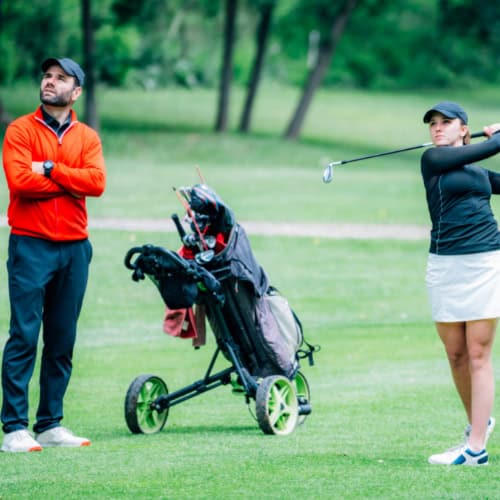
While self-analysis and solo practice can be helpful, sometimes there’s no substitute for the guidance of a qualified instructor. A good coach can identify flaws in your technique that you might miss on your own, and provide drills and exercises to help you correct them.
When looking for a coach, seek out someone who has experience working with golfers of your skill level and who uses a teaching style that resonates with you. Some coaches are more technical and data-driven, while others focus more on feel and visualization. Find someone who aligns with your learning style and goals.
Frequently Asked Questions
Here are answers to some commonly asked questions about golf drives. We compiled these to help you know as much as possible about the various techniques to perfect your drives.
What is the best driver for beginners?
When starting out, look for a driver with a large clubhead and a high loft (10.5 or 12 degrees). These features provide more forgiveness on off-center hits and help launch the ball higher, making it easier to achieve consistent shots.
How can I hit the golf ball further?
To increase your driving distance, focus on generating clubhead speed through proper technique. Key factors include maintaining a wide arc in your swing, utilizing your body’s rotation, and making solid contact with the ball.
Strength and flexibility training can also help.
You may also go through our detailed guide on How to Hit the Ball Farther.
What are the most common mistakes when driving the ball?
Common driving mistakes include incorrect grip, poor posture, misaligned stance, and an inadequate weight shift during the swing. Other issues can be swinging too hard, lifting your head too early and failing to complete your follow-through.
How important is the follow-through in a golf swing?
The follow-through is crucial for maintaining clubhead speed and direction through impact. An abbreviated follow-through can cause inconsistent contact and a loss of power. Practice swinging to a full, balanced finish to promote solid, accurate drives.
Should I adjust my stance for different types of shots?
Yes, small stance adjustments can help shape your drives. For a fade, open your stance slightly and align your body left of the target. For a draw, do the opposite: close your stance slightly and align your body right of the target.
Remember to make a smooth swing along your body alignment.
What are the best warm-up exercises before driving?
Before teeing off, perform dynamic stretches to loosen your muscles and joints. Rotational exercises like trunk twists and arm circles are particularly helpful. Gradually progress from short, easy swings to full swings with your driver.
Final Thoughts
Mastering your golf drive is a lifelong journey of learning and improvement that requires patience, practice and perseverance. By understanding the fundamentals, honing your technique and cultivating mental resilience, you can unlock your full potential on the tee box and beyond.
Remember to celebrate your successes, learn from your mistakes and never stop having fun. The discipline, focus and determination you develop through mastering your drive can translate to success in all aspects of life.
If you have additional questions, please contact us; we will be happy to help.





